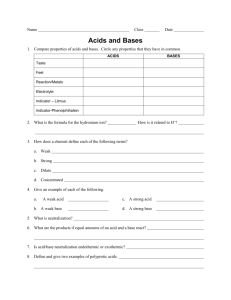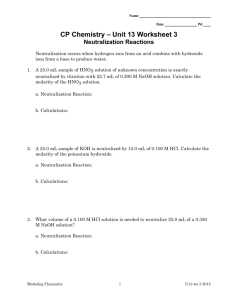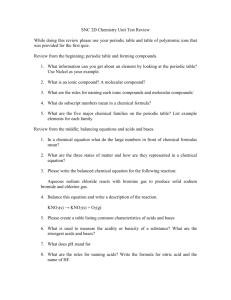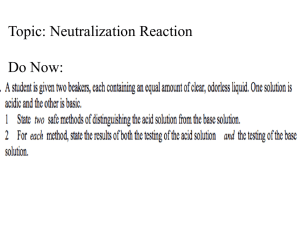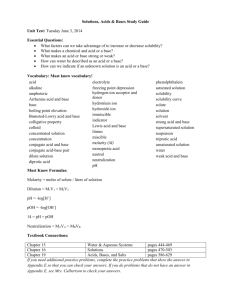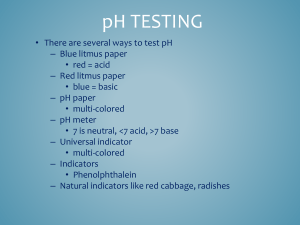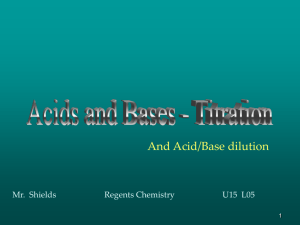Neutralization Reactions
advertisement
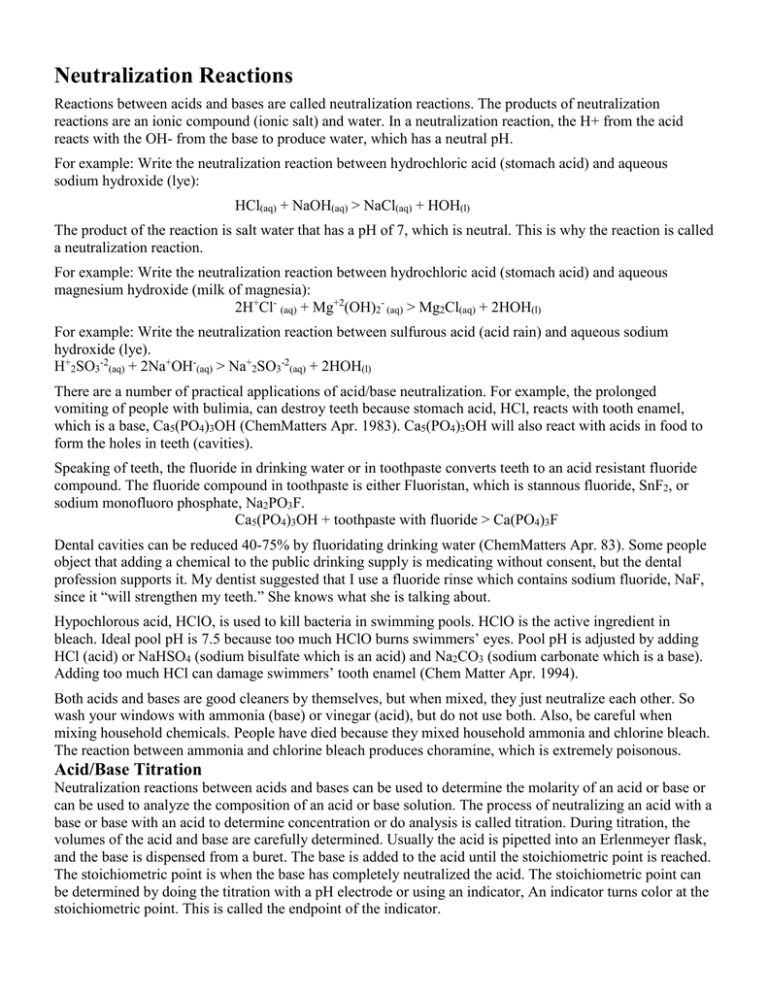
Neutralization Reactions Reactions between acids and bases are called neutralization reactions. The products of neutralization reactions are an ionic compound (ionic salt) and water. In a neutralization reaction, the H+ from the acid reacts with the OH- from the base to produce water, which has a neutral pH. For example: Write the neutralization reaction between hydrochloric acid (stomach acid) and aqueous sodium hydroxide (lye): HCl(aq) + NaOH(aq) > NaCl(aq) + HOH(l) The product of the reaction is salt water that has a pH of 7, which is neutral. This is why the reaction is called a neutralization reaction. For example: Write the neutralization reaction between hydrochloric acid (stomach acid) and aqueous magnesium hydroxide (milk of magnesia): 2H+Cl- (aq) + Mg+2(OH)2- (aq) > Mg2Cl(aq) + 2HOH(l) For example: Write the neutralization reaction between sulfurous acid (acid rain) and aqueous sodium hydroxide (lye). H+2SO3-2(aq) + 2Na+OH-(aq) > Na+2SO3-2(aq) + 2HOH(l) There are a number of practical applications of acid/base neutralization. For example, the prolonged vomiting of people with bulimia, can destroy teeth because stomach acid, HCl, reacts with tooth enamel, which is a base, Ca5(PO4)3OH (ChemMatters Apr. 1983). Ca5(PO4)3OH will also react with acids in food to form the holes in teeth (cavities). Speaking of teeth, the fluoride in drinking water or in toothpaste converts teeth to an acid resistant fluoride compound. The fluoride compound in toothpaste is either Fluoristan, which is stannous fluoride, SnF2, or sodium monofluoro phosphate, Na2PO3F. Ca5(PO4)3OH + toothpaste with fluoride > Ca(PO4)3F Dental cavities can be reduced 40-75% by fluoridating drinking water (ChemMatters Apr. 83). Some people object that adding a chemical to the public drinking supply is medicating without consent, but the dental profession supports it. My dentist suggested that I use a fluoride rinse which contains sodium fluoride, NaF, since it “will strengthen my teeth.” She knows what she is talking about. Hypochlorous acid, HClO, is used to kill bacteria in swimming pools. HClO is the active ingredient in bleach. Ideal pool pH is 7.5 because too much HClO burns swimmers’ eyes. Pool pH is adjusted by adding HCl (acid) or NaHSO4 (sodium bisulfate which is an acid) and Na2CO3 (sodium carbonate which is a base). Adding too much HCl can damage swimmers’ tooth enamel (Chem Matter Apr. 1994). Both acids and bases are good cleaners by themselves, but when mixed, they just neutralize each other. So wash your windows with ammonia (base) or vinegar (acid), but do not use both. Also, be careful when mixing household chemicals. People have died because they mixed household ammonia and chlorine bleach. The reaction between ammonia and chlorine bleach produces choramine, which is extremely poisonous. Acid/Base Titration Neutralization reactions between acids and bases can be used to determine the molarity of an acid or base or can be used to analyze the composition of an acid or base solution. The process of neutralizing an acid with a base or base with an acid to determine concentration or do analysis is called titration. During titration, the volumes of the acid and base are carefully determined. Usually the acid is pipetted into an Erlenmeyer flask, and the base is dispensed from a buret. The base is added to the acid until the stoichiometric point is reached. The stoichiometric point is when the base has completely neutralized the acid. The stoichiometric point can be determined by doing the titration with a pH electrode or using an indicator, An indicator turns color at the stoichiometric point. This is called the endpoint of the indicator. Acid/Base Titration This work sheet will help you learn the process. THIS IS NOT A WET LAB! Titration is used to determine the molarity of an unknown concentration of acid or base or to determine the percentage acid or base in a substance. Stoichiometry is used to do the calculations. 1. Problem: What is the molarity of a NaOH solution, if 10.0 mL of the NaOH are required to neutralize 12.0 mL of 2.0M H2SO4? a) Write a balanced equation that shows the stoichiometry between the acid and the base. ____________ + ______________ _____________ + _____________ DO THIS THE ANSWERS ARE POSTED ON THE BLACK BOARD. You must do this activity in order to do the rest of this unit. b) Draw a picture of the situation: What is in the buret?_______________ What is in the Erlenmeyer flask?______________ c) Calculate the number of moles of H2SO4. d) Use the mole to mole ratio to determine how many moles of NaOH will be neutralized by this much acid. e) Calculate molarity of the base. f) Will the stoichiometric solution be acid, basic or neutral? 2. A student titrates vinegar, HC2H3O2, from the grocery store with the standard base (A standard base is one for which you know the M) from problem #1. She finds that it takes 15.0 mL to neutralize 35.5 mL of the HC2H3O2. What is the concentration of the HC2H3O2?
